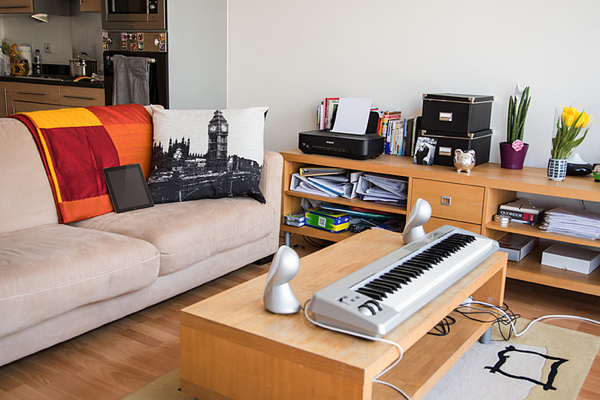Our mind is fascinating: we are able to immerse ourselves in a tiny screen and be completely inside that. Sometimes we forget about the real size of that screen. See the photo below: there’s an iPad in it, and what seems to be a whole world, here is resized to its real proportion: a tiny surface in a wide environment.

There’s a reason why certain “old school” actions and objects still exists, and it’s not just a matter of costs. Whiteboards are incredibly powerful because people move around them, because they are big, because you can sketch quickly. Size does matter for a lot of different applications.
In other terms: the digital world today is still confronted with the same problem it had at the beginning: computers have a difficult time interacting with humans and the environment. Their power has grown exponentially, but the input and output of these smart objects is still incredibly narrow.
However, this seems the time where this is changing. There are few clear signals you probably have already noticed:
- The Wiimote. The Wii has been the very first mass-market device that used an input device that was not only more natural, but also created a fuller body experience.
- Kinect. This feels like a natural follow up to the Wiimote: no device anymore, but a full body experience.
- Leap Motion. A technology similar to Kinect but for your hands with an incredible degree of precision.
- Touchscreens. These are simpler, yes, but they reduced the distance between man and machine, allowing what’s technically known as “direct manipulation” of digital objects.
- Internet of Things. This is a huge bucket, but there are a lot of items in there that extend the reach of computers in different ways. Often, internet of things object have additional sensors, new input devices, and new output devices.
- Quantified self. This movement is very interesting because creates devices (in a sense, internet of things objects) that have sensors able to communicate back with the users. Think about the Nike+ and the Jawbone Up.
- IllumiRoom. This wonderful prototype by Microsoft extends the screen beyond its limits by using a projector to extend the screen.
- Siri & Google Glass. Human language is one of the best means of communications and having a computer understanding it is excellent.
What’s interesting here is that even if all of them have limitations they are (almost) all consumer products, in some case wildly successful. The Wiimote isn’t that precise, Kinect is even less precise and actually loses the physical touch feedback of things. Touchscreens are less precise than mice but more direct and simple and bring back a bit of touch sensation. Internet of things objects are often very simple input devices as the Nike+ is and IllumiRoom is a prototype still, and in the end it’s just a smart projector.
On the other side, all of them are making the computer nearer to humans. It’s them learning from us, not the other way around anymore. Image recognition is playing for example a bigger and bigger part in this, as speech recognition. These are all right now research-heavy activities that we are still trying to make perfect.
If you pull all these things together you see a clear trend. A trend appeared recently that is extending the input and output capabilities of our computing devices. Computing power isn’t anymore a problem, input/output is.
The internet of things trend in a certain way anticipated this, but it was too much focused on the objects themselves. What we are seeing here is an extension in all directions of human-machine interactions techniques. More sensors. More feedback.
A lot of people see certain technology advancements as science fiction made real. We saw the iPhone and we thought about Star Trek’s Tricorder. We saw the Kindle and we thought about The Hitchhiker’s Guide to the Galaxy.
When I try to pull together all the new input/output mechanisms like the ones I listed above I see another science fiction item: the computer in Isaac Asimov’s Foundation Cycle that could be put in the middle of the room and could transform the room in an interactive space.
I don’t have to stretch my imagination to think of walking into a hotel room, turn on my computer and suddenly have the room becoming my workspace. The computer has scanned all the available surfaces and projected on them my “desktop”. It even changed the “wallpaper” of the room itself.
Maybe this specific device I took from Asimov, able to trasform physical, immutable spaces in digital, mutable environments, will never exist in such a shape, even if Frog did an interesting prototype in that direction. However, it is a good symbol of the mix of technologies we are seeing. Have a look again at the initial photo, or take a few steps back from the screen you’re using, and wonder how much more we could do to get a screen called room.
These are exciting times.